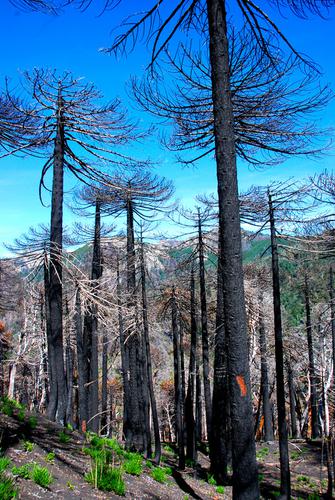当前位置:
X-MOL 学术
›
Appl. Veg. Sci.
›
论文详情
Our official English website, www.x-mol.net, welcomes your
feedback! (Note: you will need to create a separate account there.)
Initial response of understory vegetation and tree regeneration to a mixed‐severity fire in old‐growth Araucaria‐Nothofagus forests
Applied Vegetation Science ( IF 2.0 ) Pub Date : 2020-02-13 , DOI: 10.1111/avsc.12479 Andres Fuentes‐Ramirez 1, 2, 3 , Christian Salas‐Eljatib 1, 4 , Mauro E González 5, 6 , Jonathan Urrutia‐Estrada 7, 8 , Paola Arroyo‐Vargas 1, 9 , Pablo Santibañez 9
Applied Vegetation Science ( IF 2.0 ) Pub Date : 2020-02-13 , DOI: 10.1111/avsc.12479 Andres Fuentes‐Ramirez 1, 2, 3 , Christian Salas‐Eljatib 1, 4 , Mauro E González 5, 6 , Jonathan Urrutia‐Estrada 7, 8 , Paola Arroyo‐Vargas 1, 9 , Pablo Santibañez 9
Affiliation

|
QUESTIONS: Fire is a key factor influencing Araucaria araucana forests, but the impact of fire severity on the understorey vegetation is not well understood. In this study we seek to answer the following questions: (a) how do initial plant diversity, composition and spatial distribution of the understorey vegetation change in response to different levels of fire severity; and (b) does the abundance of dominant tree species exhibit different patterns across a fire severity gradient shortly after fire? LOCATION: Old‐growth Araucaria araucana–Nothofagus pumilio forests in the Andes of south‐central Chile (38° S, 71° W) burned in 2015. METHODS: We evaluated the post‐fire plant regeneration across a fire severity gradient ranging from unburned forests to areas of high fire severity. One year after fire (in February 2016), we measured woody and herbaceous species richness, abundance, height, origin (native vs exotic species), life forms and the spatial pattern of plant recovery. RESULTS: Plant species richness and abundance were significantly higher within the unburned forest and low fire severity areas one year after fire, compared to areas of high and moderate fire severity. Overall, nearly 50% of the species present in the unburned forest were not found in areas of high severity, including the tree Nothofagus pumilio. Rapid vegetative resprouting of pioneer species such as Chusquea culeou resulted in an aggregated spatial distribution of plants after fire. CONCLUSIONS: Plant diversity and the abundance of Araucaria araucana and Nothofagus pumilio were reduced in areas of high fire severity one year after fire. Exotic species were more abundant within areas of low severity, being likely mediated by cattle browsing. Our research makes clear the potential changes in forest composition and structure if dominant tree species are not capable of recovering after fire. We recommend the exclusion of cattle within fire‐affected areas and planting Nothofagus pumilio in areas of high fire severity.
中文翻译:

林下植被和树木再生对老生长南洋杉-Nothofagus 林中混合严重性火灾的初始响应
问题:火灾是影响南洋杉林的关键因素,但火灾严重程度对林下植被的影响尚不清楚。在这项研究中,我们试图回答以下问题: (a) 初始植物多样性、林下植被的组成和空间分布如何随着不同程度的火灾严重程度而变化;(b) 在火灾发生后不久,主要树种的丰度是否在火灾严重程度梯度上表现出不同的模式?地点:2015 年,智利中南部安第斯山脉(南纬 38°,西经 71°)的古老生长的南洋杉-Nothofagus pumilio 森林被烧毁。森林到火灾严重程度高的地区。火灾一年后(2016 年 2 月),我们测量了木本和草本物种的丰富度、丰度、高度、起源(本地与外来物种)、生命形式和植物恢复的空间格局。结果:与火灾发生一年后未燃烧的森林和低火灾严重程度区域内的植物物种丰富度和丰度相比,火灾严重程度较高和中等的区域显着更高。总体而言,在未烧毁森林中存在的近 50% 的物种在严重程度较高的地区未发现,包括 Nothofagus pumilio 树。先驱物种(如 Chusquea culeou)的快速营养再芽导致火灾后植物的聚集空间分布。结论:火灾一年后,在火灾严重程度高的地区,植物多样性和南洋杉和 Nothofagus pumilio 的数量减少。外来物种在严重程度较低的地区更为丰富,这可能是由牛浏览介导的。我们的研究表明,如果优势树种在火灾后无法恢复,森林组成和结构的潜在变化。我们建议将牛排除在受火灾影响的地区,并在火灾严重程度高的地区种植 Nothofagus pumilio。
更新日期:2020-02-13
中文翻译:

林下植被和树木再生对老生长南洋杉-Nothofagus 林中混合严重性火灾的初始响应
问题:火灾是影响南洋杉林的关键因素,但火灾严重程度对林下植被的影响尚不清楚。在这项研究中,我们试图回答以下问题: (a) 初始植物多样性、林下植被的组成和空间分布如何随着不同程度的火灾严重程度而变化;(b) 在火灾发生后不久,主要树种的丰度是否在火灾严重程度梯度上表现出不同的模式?地点:2015 年,智利中南部安第斯山脉(南纬 38°,西经 71°)的古老生长的南洋杉-Nothofagus pumilio 森林被烧毁。森林到火灾严重程度高的地区。火灾一年后(2016 年 2 月),我们测量了木本和草本物种的丰富度、丰度、高度、起源(本地与外来物种)、生命形式和植物恢复的空间格局。结果:与火灾发生一年后未燃烧的森林和低火灾严重程度区域内的植物物种丰富度和丰度相比,火灾严重程度较高和中等的区域显着更高。总体而言,在未烧毁森林中存在的近 50% 的物种在严重程度较高的地区未发现,包括 Nothofagus pumilio 树。先驱物种(如 Chusquea culeou)的快速营养再芽导致火灾后植物的聚集空间分布。结论:火灾一年后,在火灾严重程度高的地区,植物多样性和南洋杉和 Nothofagus pumilio 的数量减少。外来物种在严重程度较低的地区更为丰富,这可能是由牛浏览介导的。我们的研究表明,如果优势树种在火灾后无法恢复,森林组成和结构的潜在变化。我们建议将牛排除在受火灾影响的地区,并在火灾严重程度高的地区种植 Nothofagus pumilio。











































 京公网安备 11010802027423号
京公网安备 11010802027423号